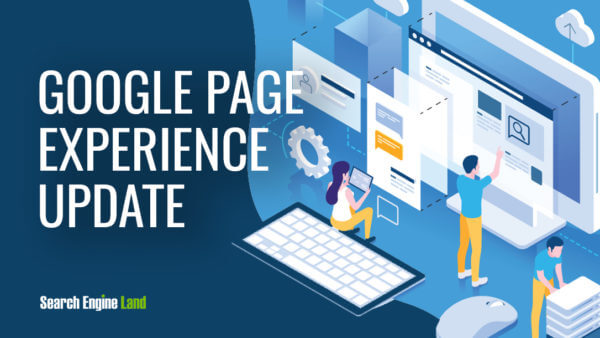SEOs discuss the new page experience signals and AMP’s fate when it’s no longer required for Top Stories.
For years, Google has been advising site owners to design their sites with users in mind. That guidance has culminated in the Page Experience update, which Google announced late last month along with the news that Accelerated Mobile Pages (AMP) will no longer be required for content to appear in Google’s mobile Top Stories carousel.
During our Page Experience session of Live with Search Engine Land, Barry Schwartz, news editor for Search Engine Land, moderated a discussion with Aja Frost, head of content SEO at HubSpot, Marty Weintraub, founder of Aimclear, and Michael King, managing director of iPullRank, to share their takes on the new algorithm, its implications, considerations for whether to continue using AMP and how to communicate the update with clients.
Google’s Page Experience update in a nutshell
The Page Experience algorithm is designed to judge web pages based on how users experience and interact with them. It encompasses numerous existing Google search ranking factors, including the safe browsing penalty, the intrusive interstitials penalty, the HTTPS ranking boost, the mobile-friendly update, the Page Speed update and Google’s Core Web Vitals.
All other considerations being equal, this update means that Google is more likely to rank your pages higher if they provide a good user experience. However, great content will still be the more important factor, Rudy Galfi, product manager at Google, told Search Engine Land. The update is scheduled to roll out sometime in 2021.
Why it may not be as impactful as previous updates
“It doesn’t feel like SEO news at all,” Weintraub said. This sentiment, which was also echoed by Frost and King, is due to the factors that constitute the Page Experience update already existing within Google’s search algorithms. “I don’t think any of this is new; it’s just a rebranding,” King said.
Although that part of the update announcement was perceived as lackluster, it still has implications for SEOs. “I think this gives you good ammunition to go to your web team or your performance team and say, ‘Hey, you know, Google . . . [is] going to release this in six months and so we need to focus on it’,” Frost said, adding, “It can be hard to convince those teams that what you want to focus on is what they want to focus on, so any kind of official update or messaging does help push your cause.”
Optimize, but don’t fixate on Core Web Vitals
“At the end of the day, all these things make our websites better and ultimately will make us more money anyway, so there’s a reason to [optimize for them] irrespective of what Google is saying,” King said, explaining why it could be advantageous to optimize for a site’s Core Web Vitals metrics.
However, fixating on such metrics could be a distraction, Frost warned. “It is easier to focus on a numerical score that you can see in Search Console then trying to produce high quality content, because that’s far more subjective,” she said.
“It could distract, just like every generation of technical SEO had the ability to distract from the core mission of communication and storytelling,” Weintraub added, caveating that building a technically sound website has always been a prerequisite for a successful online presence. “You just can’t suck too much there if you want to play; then, there’s the real conversation about what we’re here for, which is filling in the gaps with your beautiful content as the right step in the process to a marketing objective,” he said.
AMP is the real news
As part of the Page Experience announcement, Google also said that it will be removing the AMP requirement for Top Stories eligibility, incorporating page experience metrics in its place. “This is what the SEO community should, and probably will, really react to — this is actually what I’ve seen the most discussion about,” Frost commented.
Maintaining AMP pages requires significant investment as it is essentially a second version of your site. A key benefit for publishers was that AMP would enable their content to surface in the Top Stories section, which can drive significant traffic to their sites. With the requirement being lifted in 2021, publishers are now reevaluating whether it will be worth it to continue maintaining AMP versions of their content.
“I don’t think that [AMP] loses value, I just also think that . . . there are better ways to achieve the same performance,” Frost said, adding that AMP is something of a proxy for the page experience factors, and that an AMP-like user experience may be required to rank in the Top Stories carousel once the change occurs.
Freeing up resources by abandoning AMP may be on the minds of many publishers, but the decision-making process is unlikely to be that simple. “I know AMP is going to go away, and if I own anything, I’m going to make you take it from me before I dismantle that thing,” Weintraub said in reference to AMP content that may continue to perform well as the restriction is lifted.
The “don’t fix it if it ain’t broken” methodology may be a viable option, but for some organizations, the tipping point may occur when major overhauls, such as a site redesign or CMS change make the cost of updating AMP content impractical given that content will be able to rank in the Top Stories section without it.
How SEOs are communicating the announcement to their clients
“We’ve just been making people aware,” King said of how he’s communicating the Page Experience update with his clients, adding that many of the page experience factors align with the guidance his agency already provides in its site audits. “This is just more reinforcement; Google is going to care about this even more, so it’s kind of like the scare value of, ‘Hey, you should actually get the thing done that we told you to get done before’,” he said.
“We’ll look at where we’re doing really well and make sure not to screw it up,” Weintraub said, noting that “if we do take down something that’s working great, we’re going to do it a piece at a time and prove that it works.”




